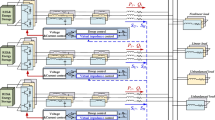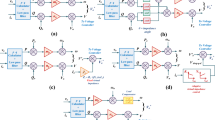Abstract
This paper investigates the role of a virtual impedance controller in improving the small-signal stability and power-sharing for an inverter-based islanded microgrid. The stability of microgrids is badly affected due to undamped low-frequency oscillations, which are often caused due to improper power-sharing among micro sources. The droop control approach has provided a viable solution to improve the power-sharing and hence the system’s stability. However, the droop gains suffer an inherent trade-off between power-sharing and stability, with a change in system dynamics like step load change. An increase in the droop gains improves power-sharing but causes low-frequency oscillating modes at the load terminals. It also deteriorates the micro sources voltage stability at the output terminals. This paper overcomes the trade-off faced by the droop controller with an approach of virtual impedance modeling along with voltage and current controller loops. A novel approach has been adapted by considering the virtual impedance as one state variable and investigating system stability by plotting the eigenvalue spectrum as a function of the droop coefficient. Participation factor-based sensitivity analysis for the proposed system has been carried out to measure the relative participation of corresponding state variables in respective oscillating modes. Time-domain simulation validates the role of virtual impedance in improving the dam** performance and enhancing the participation of DG’s during the transient mode. It also provides an insight into the role of a virtual impedance controller in improving reactive power sharing and voltage stability.





















Similar content being viewed by others
References
Lasseter RH, Eto JH, Schenkman B, Stevens J, Vollkommer H, Klapp D, Linton E, Hurtado H, Roy J (2011) CERTS microgrid laboratory test bed. IEEE Trans Power Delivery 26(1):325. https://doi.org/10.1109/TPWRD.2010.2051819
Fan L (2017) Frequency Control. In: Control and Dynamics in Power Systems and Microgrids, pp 29–82. CRC Press
Bevrani H, François B, Ise T (2017) Microgrid dynamics and control. Wiley
Rajamand S (2020) Synchronous generator control concept and modified droop for frequency and voltage stability of microgrid including inverter-based DGs. J Electr Engi Technol 15(3):1035
Farrokhabadi M, Cañizares CA, Simpson-Porco JW, Nasr E, Fan L, Mendoza-Araya PA, Tonkoski R, Tamrakar U, Hatziargyriou N, Lagos D et al (2019) Microgrid stability definitions, analysis, and examples. IEEE Trans Power Syst 35(1):13
Le J, Zhao L, Liao X, Zhou Q, Liang H (2021) Stability analysis of grid-connected inverter system containing virtual synchronous generator under time delay and parameter uncertainty. J Electr Eng Technol 16(4):1779–1792
Patan MK, Raja K, Azaharahmed M, Prasad CD, Ganeshan P (2021) Influence of primary regulation on frequency control of an isolated microgrid equipped with crow search algorithm tuned classical controllers. J Electr Eng Technol 16(2):681
Blaabjerg F, Teodorescu R, Liserre M, Timbus A (2006) Overview of control and grid synchronization for distributed power generation systems. IEEE Trans Industr Electron 53(5):1398. https://doi.org/10.1109/TIE.2006.881997
Bevrani H (2014) Robust power system frequency control
Hoang KD, Lee HH (2020) Economic power sharing to minimize generation cost in a DC microgrid. J Electr Eng Technol 15(2):737
Dragičević T, Lu X, Vasquez JC, Guerrero JM (2015) DC microgrids-Part I: a review of control strategies and stabilization techniques. IEEE Trans Power Electron 31(7):4876
Bevrani H (2014) Frequency control in microgrids. Robust Power System Frequency Control, pp 319–347
Majumder R, Chaudhuri B, Ghosh A, Majumder R, Ledwich G, Zare F (2009) Improvement of stability and load sharing in an autonomous microgrid using supplementary droop control loop. IEEE Trans Power Syst 25(2):796
Mahmood H, Michaelson D, Jiang J (2014) Accurate reactive power sharing in an islanded microgrid using adaptive virtual impedances. IEEE Trans Power Electron 30(3):1605–1617
Wang X, Li YW, Blaabjerg F, Loh PC (2014) Virtual-impedance-based control for voltage-source and current-source converters. IEEE Trans Power Electron 30(12):7019
Hosseinimehr T, Ghosh A, Shahnia F (2017) Cooperative control of battery energy storage systems in microgrids. Int J Electr Power Energy Syst 87:109
Fani B, Zandi F, Karami-Horestani A (2018) An enhanced decentralized reactive power sharing strategy for inverter-based microgrid. Int J Electr Power Energy Syst 98:531
Macana CA, Mojica-Nava E, Pota HR, Guerrero J, Vasquez JC (2020) Accurate proportional power sharing with minimum communication requirements for inverter-based islanded microgrids. Int J Electr Power Energy Syst 121:106036
Han Y, Ning X, Li L, Yang P, Blaabjerg F (2021) Droop coefficient correction control for power sharing and voltage restoration in hierarchical controlled DC microgrids. Int J Electr Power Energy Syst 133:107277
Zhong QC (2011) Robust droop controller for accurate proportional load sharing among inverters operated in parallel. IEEE Trans Industr Electron 60(4):1281
Sreekumar P, Khadkikar V (2015) A new virtual harmonic impedance scheme for harmonic power sharing in an islanded microgrid. IEEE Trans Power Delivery 31(3):936
Zhang J, Shu J, Ning J, Huang L, Wang H (2018) Enhanced proportional power sharing strategy based on adaptive virtual impedance in low-voltage networked microgrid. IET Gener Trans Distrib 12(11):2566
Han Y, Li H, Shen P, Coelho E, Guerrero J (2017) Review of active and reactive power sharing strategies in hierarchical controlled microgrids. IEEE Trans Power Electron 32(3):2427. https://doi.org/10.1109/TPEL.2016.2569597
Lu X, Wang J, Guerrero JM, Zhao D (2016) Virtual-impedance-based fault current limiters for inverter dominated AC microgrids. IEEE Trans on Smart Grid 9(3):1599
Paquette AD, Divan DM (2014) Virtual impedance current limiting for inverters in microgrids with synchronous generators. IEEE Trans Ind Appl 51(2):1630
Micallef A, Apap M, Spiteri-Staines C, Guerrero JM (2015) Mitigation of harmonics in grid-connected and islanded microgrids via virtual admittances and impedances. IEEE Trans Smart Grid 8(2):651
Eskandari M, Li L (2019) Microgrid operation improvement by adaptive virtual impedance. IET Renew Power Gener 13(2):296
Wei B, Marzàbal A, Ruiz R, Guerrero JM, Vasquez JC (2018) DAVIC: a new distributed adaptive virtual impedance control for parallel-connected voltage source inverters in modular UPS system. IEEE Trans Power Electron 34(6):5953
Guerrero JM, De Vicuna LG, Matas J, Castilla M, Miret J (2005) Output impedance design of parallel-connected UPS inverters with wireless load-sharing control. IEEE Trans Industr Electron 52(4):1126
Guo L, Zhang S, Li X, Li YW, Wang C, Feng Y (2016) Stability analysis and dam** enhancement based on frequency-dependent virtual impedance for DC microgrids. IEEE J Emerg Sel Top Power Electron 5(1):338
Wu X, Shen C, Iravani R (2016) Feasible range and optimal value of the virtual impedance for droop-based control of microgrids. IEEE Trans Smart Grid 8(3):1242
Pogaku N, Prodanovic M, Green TC (2007) Modeling, analysis and testing of autonomous operation of an inverter-based microgrid. IEEE Trans Power Electron 22(2):613
Kundur P (1994) Power system stability and Control Tata-McGraw Hill Co. Avenue of the Americas 1221
Li Z, Shahidehpour M (2017) Small-signal modeling and stability analysis of hybrid AC/DC microgrids. IEEE Trans Smart Grid 10(2):2080
Hamzeh M, Ghazanfari A, Mohamed YARI, Karimi Y (2015) Modeling and design of an oscillatory current-sharing control strategy in DC microgrids. IEEE Trans Industr Electron 62(11):6647
Hamzeh M, Ghafouri M, Karimi H, Sheshyekani K, Guerrero JM (2016) Power oscillations dam** in DC microgrids. IEEE Trans Energy Convers 31(3):970
Cao W, Ma Y, Wang F, Tolbert LM, Xue Y (2020) Low-frequency stability analysis of inverter-based islanded multiple-bus AC microgrids based on terminal characteristics. IEEE Trans Smart Grid 11(5):3662
Rashidirad N, Hamzeh M, Sheshyekani K, Afjei E (2017) An effective method for low-frequency oscillations dam** in multibus DC microgrids. IEEE J Emerg Sel Top Circ Syst 7(3):403
Lu X, Sun K, Guerrero JM, Vasquez JC, Huang L, Wang J (2015) Stability enhancement based on virtual impedance for DC microgrids with constant power loads. IEEE Trans Smart Grid 6(6):2770
Zhu Y, Zhuo F, Wang F, Liu B, Gou R, Zhao Y (2015) A virtual impedance optimization method for reactive power sharing in networked microgrid. IEEE Trans Power Electron 31(4):2890
Vijay A, Parth N, Doolla S, Chandorkar MC (2021) An adaptive virtual impedance control for improving power sharing among inverters in islanded AC microgrids. IEEE Trans Smart Grid 12(4):2991
Razi R, Iman-Eini H, Hamzeh M, Bacha S (2020) A novel extended impedance-power droop for accurate active and reactive power sharing in a multi-bus microgrid with complex impedances. IEEE Trans Smart Grid 11(5):3795
Gu Y, Li W, He X (2014) Frequency-coordinating virtual impedance for autonomous power management of DC microgrid. IEEE Trans Power Electron 30(4):2328
Yazdani A, Iravani R (2010) Voltage-sourced converters in power systems: modeling, control, and applications. Wiley
Laaksonen H, Saari P, Komulainen R (2005) Voltage and frequency control of inverter based weak LV network microgrid. In: 2005 International Conference on Future Power Systems, p 6, IEEE
Rocabert J, Luna A, Blaabjerg F, Rodriguez P (2012) Control of power converters in AC microgrids. IEEE Trans Power Electron 27(11):4734
Yao W, Chen M, Matas J, Guerrero JM, Qian ZM (2010) Design and analysis of the droop control method for parallel inverters considering the impact of the complex impedance on the power sharing. IEEE Trans Industr Electron 58(2):576
Author information
Authors and Affiliations
Corresponding author
Ethics declarations
Conflict of interest
The authors declare that they have no conflict of interest.
Additional information
Publisher's Note
Springer Nature remains neutral with regard to jurisdictional claims in published maps and institutional affiliations.
Appendices
Appendix
Power Controller Modelling
Virtual Impedance Modelling
Current Controller Modelling
Filter Modelling
System Parameters
See Table 7.
Inverter Modelling
Rights and permissions
Springer Nature or its licensor (e.g. a society or other partner) holds exclusive rights to this article under a publishing agreement with the author(s) or other rightsholder(s); author self-archiving of the accepted manuscript version of this article is solely governed by the terms of such publishing agreement and applicable law.
About this article
Cite this article
Prasad, P.S., Parimi, A.M. Design and Analysis of Decentralized Virtual Impedance Based Controller for Enhancing Power Sharing and Stability in an Islanded Microgrid. J. Electr. Eng. Technol. 18, 1769–1783 (2023). https://doi.org/10.1007/s42835-022-01336-4
Received:
Revised:
Accepted:
Published:
Issue Date:
DOI: https://doi.org/10.1007/s42835-022-01336-4




